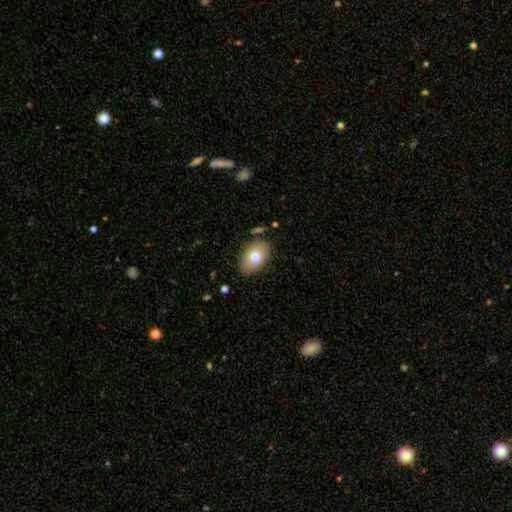
| Frankfurt Quasar Monitoring |
| OQ 530 |
| Cross-Identifications | OQ+530, PG 1418+546, S4 1418+54, CSO 633 TXS 1418+546, GB6 J1419+5423, GC 1418+54 2E 1418.1+5436, SDSS J141946.60+542314.8 87GB 141807.0+543717, WMAP J1419+5425 SBS 1418+546, RGB J1419+543, 1418+546 CXO J141946.6+542314, QSO B1418+54 IRAS F14180+5437, RX J1419.7+5423 GALEXASC J141946.61+542315.9 |
| Equat. coordinates | RA 14 19 46.6 DE +54 23 14 (J2000) |
| Constellation | Bootes |
| Type | BL Lac |
| Redshift | z=0.152 |
| Distance (2) (3) |
608 Mpc |
| Total mag range (mv) (4) | 10.8 - 16.5 |
| Catalog Magnitude (1) | 15.65 |
| Absolute Magnitude (1) | -23.7 MB |
| Light Travel-Time (2) | 1.847 × 109 yrs |

Comparison stars
| star | V | B-V | U-B |
| A | 9.27 | 0.55 | 0.05 |
| B | 12.81 | 0.88 | 0.56 |
| C | 14.29 | 0.62 | 0.13 |
| D | 13.66 | 0.55 | -0.03 |
| E | 15.89 | 0.80: | 1.14: |
| G | 14.94 | 0.53 | -0.02 |

 Credit: SDSS /
Size 3´× 3´
OQ 530 with a bright star-like nucleus (apparent diameter 15"×10") |
 Credit: Nilsson et
al. (2003) / Size 44.2" × 44.2"
This
R-band image by the Nordic OpticalTelescope shows the host galaxy as an elongated disk galaxy (image inverted) |

| OQ
530 = 1418+546 is a violently variable BL Lac object in north-eastern
Bootes, very close to the constellation Ursa Major. The designation OQ 530
refers to the radio survey of the Ohio State
University (OQ) where this object was discovered as a radio source.
Soon after the discovery, this radio source was identified with a
star-like object by the Case University Survey (CSO). OQ 530 is a radio
loud object, and as such, it has been catalogued by various other radio
surveys. Radio interferometry revealed a
radio jet extending to the southeast. The
high resolution images above clearly show this BL Lac object at the
centre of an elongated disk galaxy. The surface brightness profile resembles
that of an S0-type
galaxy, although
some authors found evidence to classify this galaxy as a flattened
elliptical. Blazar OQ 530 is both a highly polarized and a violently variable object. The total optical range was found to be nearly 6 magnitudes in the optical! Intraday optical variability has been recorded as well. CCD observers, as well as visual observers, shall use the comparison stars given above. Other photometric sequences were published by Smith et al. (1985) and the Perugia Blazar List. Visual observers need at least a 14-inch telescope or larger to glimpse this stellar object. Visually, no hints of the host galaxy can be found even with very large aperture telescopes. ____________
Let´s
have a look at some interesting observing targets near OQ 530.
Observers who like to focus on some more very old quasi-stellar photons
may turn to a bright 14-mag quasar, located some 10° to the north: PG:1351+64
is a low amplitude variable object at a distance of 1.1×109
light-years. CCD observers may recognize another faint quasi stellar object in their CCD frames: SBS 1418+548, an 18-mag high redshift quasar, denoted as "Q" at the upper edge of the finding chart. Quasar SBS 1418+548 has a redshift of z=2.257, which corresponds to a light travel-time of about 10×109 yrs (see further data below). Galaxy fans find three deep sky showpieces nearby. M101, a large face-on spiral, can be found some 2.4° to the east. Pointing the telescope 10.5° to the SE of OQ 530 shows M51, the "Whirlpool galaxy", as well as its bright companion, NGC 5195. Finally turn 6.8° to the west of OQ 530 and visit M102 (NGC 5866), a bright 10.8-mag edge-on galaxy, with a narrow dust lane intersecting the bright bulge. Back in our Milky Way galaxy, we close our deep sky session with a look at a pair of bright and easy double stars, separated in the sky by only half a degree. Kappa (17) Bootis is located some 2.7° SSE of OQ 530. It consists of a 4.5-mag primary and a 6.6-mag companion, separated by 13.7". Nearby double star Iota (21) Bootis is located just 35 arcmin SE. It has a 4.9-mag primary and a 7.5-mag companion, separated by 40". -------------------------------------------------------- [SBS 1418+548 = SDSS J141954.26+543014.8: RA 14 19 54.1, DE +54 30 15, z=2.257, 18.28 mag]* *Data from Véron-Cetty & Véron (2006) |
| Fan, J.H., Lin, R.G. 1999, ApJS, 121, 131; Infrared Variation of Radio-selected BL Lacertae Objects. Gabuzda, D.C., Pushkarev, A.B., Cawthorne, T.V. 1999, MNRAS, 307, 725; The lambda=6cm VLBI polarization structure of nine BL Lacertae objects. Miller, H.R., Wilson, J.W., et al. 1984, A&AS, 57, 353; Photoelectric comparison sequences in the fields of B2 1308+326 and 1418+54. Nilsson, K., Pursimo, T., et al. 2003, A&A, 400, 95; R-band imaging of the host galaxies of RGB BL Lacertae objects. Smith, P.S., Balonek, T.J., et al. 1985, AJ, 90, 1184; UBVRI Field Comparison Stars for Selected Aktive Quasars and BL Lacertae Objects. Steinicke, W.; Katalog heller Quasare und BL Lacertae Objekte; Umkirch 1998. Stickel, M., Fried, J.W., Kuehr, H. 1993, A&AS, 98, 393; The complete sample of 1 Jy BL Lac objects. II - Observational data. Véron-Cetty, M.-P., Véron, P. 2001, A&A 374, 92; A Catalogue of Quasars and Active Nuclei: 10th edition. Véron-Cetty, M.-P., Véron, P. 2003, A&A 412, 399; A Catalogue of Quasars and Active Nuclei: 11th edition. Véron-Cetty, M.-P., Véron, P. 2006, A&A 455, 776; A Catalogue of Quasars and Active Nuclei: 12th edition. Véron-Cetty, M.-P., Véron, P. 2010, A&A 518, 10; A Catalogue of Quasars and Active Nuclei: 13th edition. |
| home |